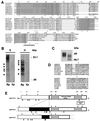A family of fibrinogen-related proteins that precipitates parasite-derived molecules is produced by an invertebrate after infection
- PMID: 9238039
- PMCID: PMC23082
- DOI: 10.1073/pnas.94.16.8691
A family of fibrinogen-related proteins that precipitates parasite-derived molecules is produced by an invertebrate after infection
Abstract
After infection with the digenetic trematode Echinostoma paraensei, hemolymph of the snail Biomphalaria glabrata contains lectins comprised of 65-kDa subunits that precipitate polypeptides secreted by E. paraensei intramolluscan larvae. Comparable activity is lacking in hemolymph of uninfected snails. Three different cDNAs with sequence similarities to peptides derived from the 65-kDa lectins were obtained and unexpectedly found to encode fibrinogen-related proteins (FREPs). These FREPs also contained regions with sequence similarity to Ig superfamily members. B. glabrata has at least five FREP genes, three of which are expressed at increased levels after infection. Elucidation of components of the defense system of B. glabrata is relevant because this snail is an intermediate host for Schistosoma mansoni, the most widely distributed causative agent of human schistosomiasis. These results are novel in suggesting a role for invertebrate FREPs in recognition of parasite-derived molecules and also provide a model for investigating the diversity of molecules functioning in nonself-recognition in an invertebrate.
Figures



References
-
- Lemaitre B, Nicolas E, Michaut L, Reichart J-M, Hoffmann J A. Cell. 1996;86:973–983. - PubMed
-
- Richards E H, Renwrantz L R. J Comp Physiol. 1991;161:43–54.
-
- Van der Knaap W P W, Loker E S. Parasitol Today. 1990;6:175–182. - PubMed
-
- Adema C M, Hertel L A, Loker E S. In: Parasites and Pathogens: Effects on Host Hormones and Behavior. Beckage N, editor. New York: Chapman & Hall; 1997. pp. 76–98.
-
- Hertel L A, Stricker S A, Monroy F P, Wilson W D, Loker E S. J Invert Pathol. 1994;64:52–61. - PubMed
Publication types
MeSH terms
Substances
Associated data
- Actions
- Actions
- Actions
- Actions
- Actions
- Actions
- Actions
- Actions
- Actions
- Actions
Grants and funding
LinkOut - more resources
Full Text Sources
Research Materials

